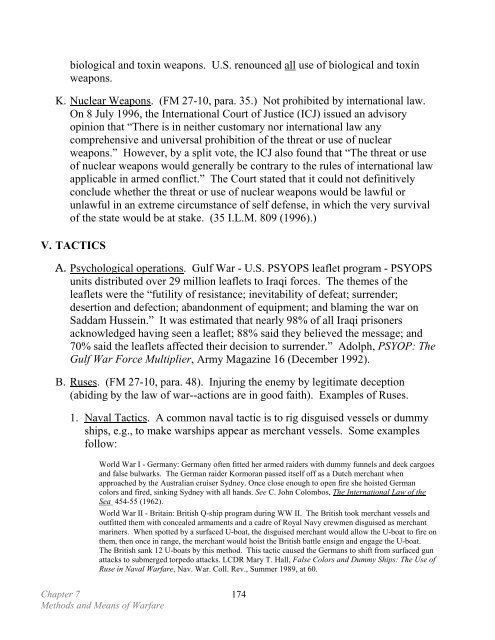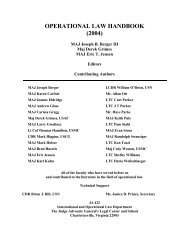Law of War Workshop Deskbook - Higgins Counterterrorism ...
Law of War Workshop Deskbook - Higgins Counterterrorism ...
Law of War Workshop Deskbook - Higgins Counterterrorism ...
You also want an ePaper? Increase the reach of your titles
YUMPU automatically turns print PDFs into web optimized ePapers that Google loves.
iological and toxin weapons. U.S. renounced all use <strong>of</strong> biological and toxinweapons.K. Nuclear Weapons. (FM 27-10, para. 35.) Not prohibited by international law.On 8 July 1996, the International Court <strong>of</strong> Justice (ICJ) issued an advisoryopinion that “There is in neither customary nor international law anycomprehensive and universal prohibition <strong>of</strong> the threat or use <strong>of</strong> nuclearweapons.” However, by a split vote, the ICJ also found that “The threat or use<strong>of</strong> nuclear weapons would generally be contrary to the rules <strong>of</strong> international lawapplicable in armed conflict.” The Court stated that it could not definitivelyconclude whether the threat or use <strong>of</strong> nuclear weapons would be lawful orunlawful in an extreme circumstance <strong>of</strong> self defense, in which the very survival<strong>of</strong> the state would be at stake. (35 I.L.M. 809 (1996).)V. TACTICSA. Psychological operations. Gulf <strong>War</strong> - U.S. PSYOPS leaflet program - PSYOPSunits distributed over 29 million leaflets to Iraqi forces. The themes <strong>of</strong> theleaflets were the “futility <strong>of</strong> resistance; inevitability <strong>of</strong> defeat; surrender;desertion and defection; abandonment <strong>of</strong> equipment; and blaming the war onSaddam Hussein.” It was estimated that nearly 98% <strong>of</strong> all Iraqi prisonersacknowledged having seen a leaflet; 88% said they believed the message; and70% said the leaflets affected their decision to surrender.” Adolph, PSYOP: TheGulf <strong>War</strong> Force Multiplier, Army Magazine 16 (December 1992).B. Ruses. (FM 27-10, para. 48). Injuring the enemy by legitimate deception(abiding by the law <strong>of</strong> war--actions are in good faith). Examples <strong>of</strong> Ruses.1. Naval Tactics. A common naval tactic is to rig disguised vessels or dummyships, e.g., to make warships appear as merchant vessels. Some examplesfollow:World <strong>War</strong> I - Germany: Germany <strong>of</strong>ten fitted her armed raiders with dummy funnels and deck cargoesand false bulwarks. The German raider Kormoran passed itself <strong>of</strong>f as a Dutch merchant whenapproached by the Australian cruiser Sydney. Once close enough to open fire she hoisted Germancolors and fired, sinking Sydney with all hands. See C. John Colombos, The International <strong>Law</strong> <strong>of</strong> theSea 454-55 (1962).World <strong>War</strong> II - Britain: British Q-ship program during WW II. The British took merchant vessels andoutfitted them with concealed armaments and a cadre <strong>of</strong> Royal Navy crewmen disguised as merchantmariners. When spotted by a surfaced U-boat, the disguised merchant would allow the U-boat to fire onthem, then once in range, the merchant would hoist the British battle ensign and engage the U-boat.The British sank 12 U-boats by this method. This tactic caused the Germans to shift from surfaced gunattacks to submerged torpedo attacks. LCDR Mary T. Hall, False Colors and Dummy Ships: The Use <strong>of</strong>Ruse in Naval <strong>War</strong>fare, Nav. <strong>War</strong>. Coll. Rev., Summer 1989, at 60.Chapter 7Methods and Means <strong>of</strong> <strong>War</strong>fare174
















